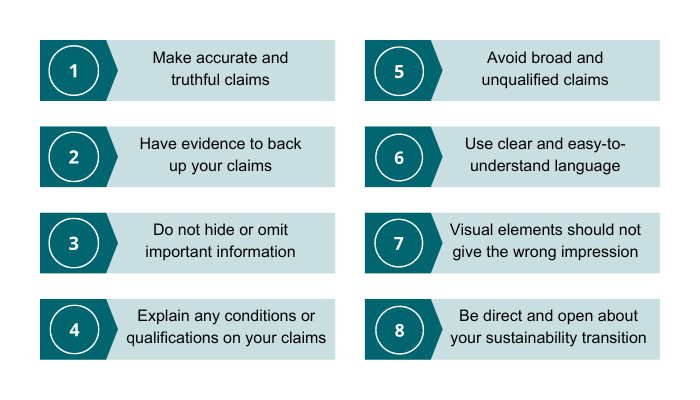Confidently communicating without greenwashing – final ACCC environmental claims guidelines

Research shows businesses often find communicating about their environmental impact challenging and can be fearful of communicating about their genuinely positive sustainability initiatives in case they’re perceived as greenwashing. Some are even practicing ‘greenhushing’. To help Australian businesses with this, the Australian Competition and Consumer Commission (ACCC) recently released ‘Making environmental claims – a guide for business’. This follows draft guidance issued in July. The guidance is designed to help businesses provide clear, accurate and trustworthy information to consumers about their environmental performance. In case you haven’t had time to read it yet, here TEM’s Head of Marketing & Corporate Affairs, Mione Collins, provides a snapshot of the key points from the draft guidance that are relevant to carbon offsetting communications to help you communicate your genuinely positive environmental impact with confidence.
The good news
The great news is that the ACCC says it “encourages businesses to take genuine steps to improve their environmental performance and share their progress with consumers. Businesses should also feel confident to advertise the environmental benefits of their products and services, and the steps they are taking to reduce their environmental impact.
What is covered in the draft guidance?
The new guidance outlines the ACCC’s view of what businesses need to do when making environmental claims that comply with the Australian Consumer Law (ACL) – which applies to all forms of marketing, from packaging to social media posts – and ACCC’s expectations for good practice when making environmental claims. It includes practical examples and principles.
What is an ‘environmental claim’?
The ACCC defines an environmental claim as “any representation made by a business in relation to its environmental impact.”
What is greenwashing?
In the guidance, the ACCC describes it as: “Greenwashing describes environmental claims that are false or misleading. The ACCC considers a business will be engaging in greenwashing where it makes a claim that represents a product, service or the business itself as better for or less harmful to the environment that it really is.”
Eight principles for trustworthy environmental and sustainability communications
The guidance includes eight principles that the ACCC encourages businesses to apply when making environmental claims to help them comply with their obligations under the ACL and allow consumers to make informed decisions. These principles are:

Parts of guidance directly relevant to carbon offsetting communications
Be direct and open about your sustainability transition
The ACCC says that businesses should make it clear which steps in their sustainability transition have been completed, and which are still in progress, and provide regular updates on their progress.
Carbon emissions-related communication
The ACCC says businesses should be careful when communicating with consumers about the greenhouse emissions associated with their products, services or business and their overall impact on climate change. When making emissions-related claims, it says it is good practice to ensure any claims “are understood by the ordinary and reasonable consumer” and that companies:
- Undertake a thorough emissions baseline assessment, using established Australian or internationally recognised methodologies.
- Provide clear information to consumers about what emissions are included and excluded from any assessment
- Clearly and transparently communicate the actions you have taken that underpin claims. For example, specifying which parts are related to emissions reductions activities, and which parts purchased offsets.
- Provide information about the types of projects that offsets have been generated from and ensure you:
- have verified them (including verifying that the emissions abatement attributable to the offset project has not already been claimed by the project owner) and that offsets representing the same emissions benefit have not been issued under multiple different registries.
- provide up-to-date information about the registry on which they are listed with details of the offsets relinquished or cancelled each year − where practicable, make this information readily accessible to consumers.
- Account for all types of greenhouse gas emissions.
- Ensure that consumers can understand from the information provided which emissions have been accounted for and avoid using headline claims that create a misleading impression, for example:
- disproportionately emphasising a claim in relation to a product, service or segment of your operations if this only represents a small proportion of your overall emissions profile.
- advertising the offering of a “carbon natural product” but not making clear this is not a default option and is depending on consumers opting in.
A case study from the guidelines – high integrity offsets
In a best practice case study in the guidance, it says when communicating about where offsets have been used, the business:
- provides details of the programs it has sourced offsets from
- takes reasonable steps to verify the integrity of the offset projects
- annually cancels or surrenders the volume of offsets consistent with achieving its goal and ensures offset cancellations are recorded in the relevant registry
- provides regular updates on its progress, including the number of offsets it has purchased and surrendered each year.
How TEM can help
Connecting our customers to high-integrity, high-quality carbon offsetting projects that they can confidently communicate about as part of their decarbonisation journey is at the heart of what we do at TEM. This includes having fully-verified carbon offsetting projects in line with ACCC guidelines. In addition to adhering to international standards, TEM carries out our own rigorous due diligence process for every project we undertake and invest in, including verification processes, to ensure its quality, integrity and measurable carbon abatement impact.
TEM works with our partners to ensure they have the information they need to appropriately and confidently communicate about the carbon projects they support and the positive impact projects have.
If you’d like to discuss this further, please reach out to our team here.
Find out more
You can read the full ACCC guidelines here: Environmental and sustainability claims –guidance for business | ACCC
Important information
Please note this blog is intended only to provide a summary and general overview. It is not intended to be comprehensive and does not constitute legal/ professional or any other type of advice. Please seek legal or other professional advice before acting or relying on any of the content and to fully understand your organisation’s obligations to do with this area.
This information has been prepared by Tasman Environmental Markets Australia Pty Ltd (TEM), a corporate authorised representative (ABN 97 659 245 011, CAR 001297708) of TEM Financial Services Pty Limited (ABN 58 142 268 479, AFSL 430036). This material is for general information only and is not intended to provide you with financial advice or take into account your objectives, financial situation or needs. While we believe that the material is correct, no warranty of accuracy, reliability or completeness is given, except for liability under statute which can’t be excluded. Before making an investment decision, you should first consider if the information is appropriate for your circumstances and seek professional financial advice. Please note past performance is not a guarantee of future performance.



